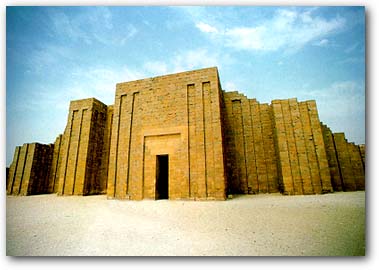| Funerary Complex of Djoser (Zoser)

The funerary complex of Djoser (Zoser) is believed to have been built around the beginning of
the 3rd Dynasty. It is a walled compound that is constructed from stone rather than the mud
brick that was used before this time. The stones that are used are different from the huge
stones used in the pyramids at Giza, in that they are small in size. Imhotep was the architect of
this revolutionary wonder. He was later worshipped as a god for the remarkable
craftsmanship in the complex. Imhotep translated into stone the early Egyptian architecture of
mud-brick, wood and reeds. This is seen in many of the monuments that are in the complex.
The entire complex was once surrounded by an enclosure wall, that when complete, was
about 600 yards (549m) long and 300 yards (274m) wide and rose to over 30 feet (9.1m).
The wall is made of brick-size stones and is very impressive in its own right. Just the size alone
would have made the wall and incredible project, but that is not the only thing impressive
about this enclosure wall. The wall has projections and recesses that would have more than
doubled the amount of stone and work required. The craftsmanship is very meticulous. The
purpose of the wall is thought to have been one of symbolic nature, not of military protection,
for the funerary complex inside.
The entrance to the complex is a very narrow passage. The gateway on the eastern wall is the
only ancient entrance to the complex. However, the wall contained several false doorways.
The entrance ceiling is a simulation of a roof made from split logs. This is the first of many
organic original imitations.
As you pass through the entrance, on the left and right, there are reproductions in stone of a
double door. The doors appear to be able to open and close. These are permanently open.
Past the double doors is the colonnade. The colonnade has almost entirely been reconstructed
by fitting bits and pieces of the stones found in the sand. There are forty columns in this area
and are thought to represent the provinces or nomes that were in existence during that time.
Originally the colonnade had a roof and would have formed a long T-shaped gallery.
The columns of the colonnade resemble bound reed bunches. Most of the columns have
seventeen stalks. The ones toward the end have nineteen, as do the double freestanding
columns on the western end. The columns are spaced closer together toward the west from
the eastern entrance. This makes the distance seem greater.
The colonnade opens up into the Great Court. There are two altars near the center of the
court. These altars are thought to have been part of the Sed (Heb-sed) festival. Very little is
known about this festival. It is thought to have been a great public event in which the king was
to run an actual race to prove his physical fitness to rule.
The Heb-sed Court is also thought to have played a part in the Sed festival. To the north of
the colonnade is a double row of shrines that is called the Heb-sed Court. Most of these
shrines have been reconstructed. At the far end of the court is the base of a statue that has
been destroyed except for four pairs of unidentified feet.
The House of the South (Southern Buildings) is just beyond the Heb-sed court. The buildings
were discovered during a 1924-26 excavation. The entrance to the southern buildings is
located between the second and third columns, which makes the entrance off-center.
The House of the North (Northern Buildings) is just further along from the House of the South.
Each column is carved to resemble an opened papyrus stalk.
On the other side of the great courtyard is the Step Pyramid. Also located in the complex is
the mortuary temple as well as the southern tomb.
|





